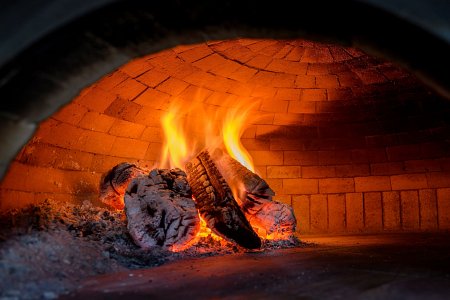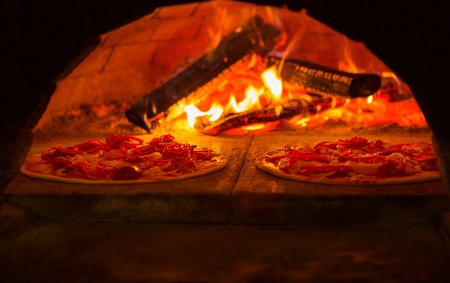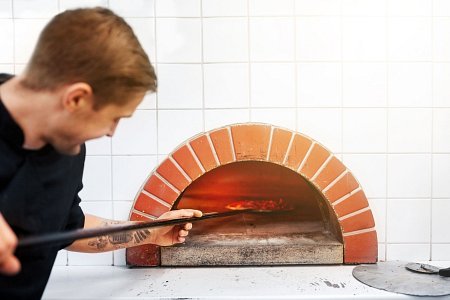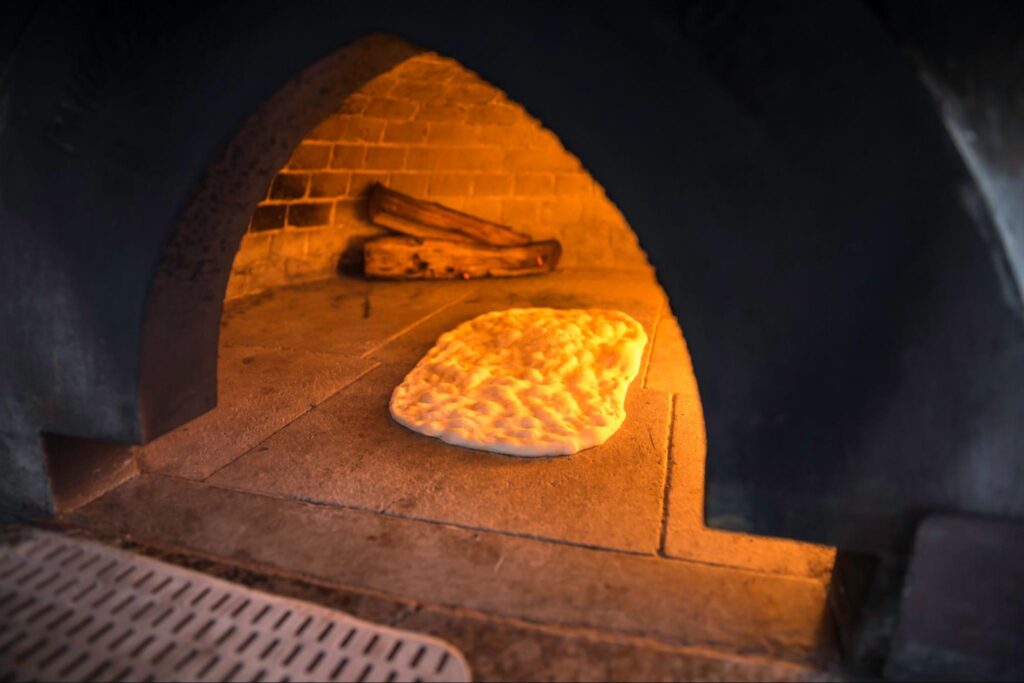Wood-fired pizza ovens have become a favourite in both domestic gardens and commercial kitchens. People enjoy the flavour, speed, and consistency that a proper wood-fired pizza oven can deliver, but few consider the materials that make this performance possible. At the centre of every reliable pizza oven is a set of fire bricks that manage heat with accuracy. These refractory materials are specifically engineered to withstand extreme temperatures, retain heat, and protect the oven from structural damage.
Good heat retention matters. A pizza oven must reach and hold high temperatures, recover heat quickly after each bake, and stay stable during long cooking sessions. Without the right materials, heat loss rises, energy consumption increases, and the quality of the pizza drops.
Fire bricks solve these problems with high thermal mass, low thermal conductivity, and exceptional durability. Understanding what makes them so effective helps explain why they are used in everything from outdoor pizza ovens to industrial furnaces.
This article looks at how fire bricks improve heat retention in pizza ovens and why they offer superior insulation and energy efficiency compared with regular bricks. Before reaching that point, we start with what these bricks are, how they are made, and where they are used.
What Fire Bricks Are and What Makes Them Unique
Fire bricks, often called refractory bricks or fireplace bricks, are heat-resistant blocks designed for high-temperature applications. Unlike standard bricks that fracture under intense heat, a fire brick is made from fire clay and other minerals that can withstand extremely high temperatures without losing strength. Their structure gives them superior heat resistance and allows them to handle rapid temperature changes that would damage regular bricks.
High-quality fire bricks usually fall into two broad categories. Dense fire bricks are strong, durable materials with high thermal mass that help an oven retain heat for long periods. Insulating fire bricks have lower thermal conductivity, which helps reduce heat loss and keeps the cooking chamber stable. Both types offer exceptional durability, but dense fire bricks are the typical choice for pizza ovens because they balance heat retention with high heat resistance.
These bricks are designed to withstand high temperatures, thermal shock, and extreme heat while maintaining structural integrity. They perform reliably in high-temperature environments because they contain minerals that resist expansion and cracking. Their ability to withstand temperatures ranging from everyday wood burning to conditions found in industrial furnace settings makes them essential in many heating applications.
Types and Variants
There are several types of refractory fire bricks used in different high heat applications. High-temperature fire bricks are built for intense heat in industrial applications such as metal casting and kiln bricks in pottery studios. Fire-resistant bricks and high-temperature fire bricks are used in industrial furnaces, wood-burning stoves, multifuel stoves, and high-temperature environments that push materials to their limits.
Some products, like fireplace bricks and refractory fire bricks, focus on both heat resistance and aesthetic stability in domestic and commercial settings. Others prioritise extreme durability for continuous industrial use. All of them share the ability to withstand extremely high temperatures and provide high heat resistance.
Common Uses Beyond Pizza Ovens
Fire bricks are not only used in pizza ovens. Their reliability makes them a standard choice in wood-burning stoves, and other wood-burning installations where intense heat and rapid temperature swings are common. They line fire pits, support metal casting equipment, and play a vital role in barbecue grill setups where high heat is unavoidable.
In industrial settings, refractory bricks are essential in industrial furnaces, kilns, and other equipment that must withstand high heat without warping. Their high thermal efficiency helps reduce energy consumption, which lowers energy costs and improves long-term performance. Because they remain stable in high heat applications, these bricks are found in both heavy industry and domestic heating systems.

Why Fire Bricks Matter in Pizza Ovens
Fire bricks play a central role in how a pizza oven performs. Their ability to retain heat, limit heat loss, and deliver stable cooking conditions makes them essential in both small wood-fired pizza ovens and larger commercial units.
High Heat Resistance for Consistent Baking
Pizza ovens depend on intense heat. When the fire is burning strongly, temperatures can rise quickly, and the material inside the oven must withstand high temperatures without weakening. Fire bricks are designed to withstand extremely high temperatures and maintain excellent heat resistance over long periods. This allows a pizza oven to stay stable during busy cooking sessions, whether in a home garden or a restaurant.
Because refractory bricks are made from fire clay and other refractory materials, they can handle rapid temperature changes without cracking. This stability means the oven floor and walls stay strong even when wood-fired operation leads to sudden bursts of intense heat. The result is a consistent cooking surface that produces even results for every pizza.
Low Thermal Conductivity and Superior Insulation
Another advantage of fire bricks is their low thermal conductivity. Materials with lower thermal conductivity slow down heat movement, which helps the oven keep its core temperature steady. This is especially important for outdoor pizza ovens that face changing weather conditions. Superior insulation ensures that heat stays inside the cooking chamber rather than escaping into the surrounding air.
These insulation properties reduce heat loss and allow the oven to hold a high temperature for longer, even after the fire has burned down. With better insulation, the oven becomes more energy efficient and needs less fuel. This is one reason why high-quality fire bricks are used in both domestic and commercial pizza ovens.
High Thermal Mass and Heat Retention
Fire bricks have high thermal mass, which means they absorb and store heat effectively. Once heated, they continue to release heat slowly and steadily. This is essential for wood-fired ovens, where short cooking times and intense heat define the final result. High thermal mass helps the oven floor stay hot enough to cook pizza bases quickly without burning them.
Dense fire bricks are particularly effective at this. They retain heat without softening or cracking under extreme temperatures. Their ability to handle rapid temperature shifts without damage makes them the most reliable material for any pizza oven that needs stable performance.
Energy Efficiency and Reduced Consumption
Because fire bricks retain heat so well, they also improve energy efficiency. A pizza oven built with refractory fire bricks consumes less fuel over time, which reduces energy consumption and lowers energy costs. Standard bricks lose heat much faster, which means the oven requires more wood to stay hot.
Using high-temperature fire bricks allows the oven to reach optimal performance with less effort. For anyone who uses a wood-fired pizza oven regularly, this difference is significant and saves fuel in every session.
How Fire Bricks Improve Performance in Wood-Fired Pizza Ovens
Once a pizza oven is heated, its internal materials must continue to handle extreme heat without losing strength or allowing temperatures to drop. Fire bricks do this with a balance of durability, insulation, and heat storage that regular bricks cannot match.
Stable Cooking Temperatures
A good pizza oven must stay hot even when the door is opened or a pizza is removed. Fire bricks help maintain stable temperatures because they absorb energy from the fire and release it steadily. This keeps the cooking chamber from cooling too quickly.
Fire bricks also recover heat quickly after each pizza is finished. This fast recovery is important in both home and commercial settings, where several pizzas may be made in a row. The ability to withstand extreme temperatures and maintain high thermal efficiency ensures the oven stays ready for the next bake.
Durability Under Extreme Heat
Wood-fired ovens often face rapid temperature changes as the fire grows, burns down, or is reloaded with wood. Many materials fail under these conditions. Fire bricks are specifically engineered to withstand temperatures ranging from moderate heat to extreme heat without cracking.
Their exceptional durability allows them to resist thermal shock and intense heat that would damage regular bricks. This makes them suitable for high heat applications found in wood-fired pizza ovens, outdoor ovens, and pizza ovens used in commercial kitchens.
Structural Integrity and Longevity
A pizza oven must stay structurally sound despite repeated exposure to high heat. Fire bricks maintain their shape and strength even in high-temperature environments. Their structural integrity protects the oven from long-term wear and keeps the cooking chamber safe.
Because these bricks offer exceptional durability, they provide long-term reliability for wood-fired pizza ovens, making them a practical choice for domestic and commercial applications. A well-built pizza oven lined with refractory bricks can last for many years with very little maintenance.

Installation and Safety Considerations
Installing fire bricks correctly is essential if you want your pizza oven to perform at a high level. Proper placement, the right bonding materials, and safe handling all help the oven retain heat and stay structurally reliable during years of use.
How to Install Fire Bricks Properly
Before you install fire bricks, check the manufacturer’s instructions. Each pizza oven design has specific requirements for spacing, layout, and the type of refractory mortar needed for secure bonding. Using the correct mortar helps the bricks stay stable when exposed to high-temperature environments. It also prevents gaps that could increase heat loss.
When laying the floor of a wood-fired pizza oven, dense fire bricks are normally placed tightly together on a level base. This creates a smooth surface that distributes heat evenly. The dome or wall area may use a combination of high-temperature fire bricks and insulating bricks to balance heat retention with superior insulation.
A careful installation gives the oven the thermal stability it needs. It also ensures the bricks can withstand high temperatures without shifting, which helps maintain optimal performance over time.
Safety Measures
Fire bricks are durable materials designed to withstand extreme heat, but they still require safe handling. Always wear protective gear such as gloves, goggles, and sturdy footwear when working with refractory materials. Cutting or shaping bricks creates dust, so proper protective gear reduces the risk of irritation.
When operating the oven, keep in mind that the internal chamber and exterior surfaces can reach extremely high temperatures. Safe working habits help ensure safety in both domestic and commercial applications.
Comparing Fire Bricks with Other Materials
Choosing the right material for a pizza oven makes a huge difference in how well it retains heat, how much fuel it uses, and how long it lasts. Fire bricks outperform standard bricks and many other refractory materials in several important ways.
Fire Bricks vs Regular Bricks
Regular bricks are not meant for high heat applications. They crack under intense heat, absorb moisture, and struggle with rapid temperature changes. They also have higher thermal conductivity, which means heat escapes more easily. This leads to higher energy consumption, inconsistent baking, and shorter material life.
Fire bricks, on the other hand, can withstand extremely high temperatures and remain stable when exposed to rapid temperature changes. Their excellent heat resistance and lower thermal conductivity help reduce heat loss. This improves energy efficiency, protects the oven’s structure, and produces better cooking results. For anyone building or repairing a pizza oven, regular bricks simply cannot match the performance of refractory fire bricks.
Fire Bricks vs Alternative Refractory Materials
Some other refractory materials are used in industrial applications such as industrial furnaces, kiln bricks, or metal casting setups. These materials may offer good performance in specialised situations, but they are not always ideal for pizza ovens.
Fire bricks strike a balance between exceptional durability, high thermal mass, and ease of installation. They are specifically engineered for heating applications that require both high heat resistance and stable heat distribution. In pizza ovens, this combination matters more than extreme strength alone. For most wood-fired ovens and outdoor ovens, fire bricks remain the most practical and effective choice. You can find all you need to build your own pizza oven at Vitcas Shop.
Practical Applications in Domestic and Commercial Pizza Ovens
Fire bricks support reliable performance across many types of pizza ovens. Whether someone is building a small outdoor unit at home or running a commercial kitchen that depends on steady output, the same principles of heat retention and durability apply.
Home Use
In domestic settings, outdoor pizza ovens benefit greatly from materials with high heat resistance and low thermal conductivity. A wood-fired pizza oven built with high-temperature fire bricks heats quickly and stays hot for long sessions. This helps the cook maintain a stable temperature even when the fire dies down.
Because dense fire bricks retain heat so effectively, they make these ovens more energy efficient. Less wood is needed, heat loss is reduced, and the oven floor stays at the right temperature for every pizza. This gives home cooks a consistent base for wood-fired pizza without constant adjustments.
Commercial Ovens
Commercial pizza ovens work under much tougher conditions. They run at high temperatures for long hours, face rapid temperature changes, and must deliver consistent results all day. Fire bricks support this by providing the structural integrity needed to withstand high heat applications as well as the extreme temperatures demanded by busy kitchens.
Their high thermal efficiency also helps reduce energy consumption. For businesses, lower fuel use means lower operating costs. High-quality fire bricks keep these ovens reliable even after years of intense heat and heavy use.

Maintenance Tips
Even though fire bricks are designed to withstand extremely high temperatures, regular care keeps them performing at their best. A well-maintained oven stays hotter for longer and remains safe for both domestic and commercial users.
Cleaning and Inspection
After each session, remove ash and debris from the oven floor. This prevents fine particles from interfering with airflow and helps the oven heat evenly the next time it is used. Periodically inspect the bricks for cracks or chips. While refractory bricks offer exceptional durability, repeated exposure to intense heat can eventually cause surface wear.
Replacing Damaged Bricks
If a brick becomes damaged, replace it before the crack spreads. A compromised brick may lose its ability to withstand high temperatures or rapid temperature changes, which can affect heat retention and safety. When replacing a brick, use refractory mortar and follow the manufacturer’s instructions to ensure a proper fit.
Protecting the Oven
If the pizza oven sits outdoors, protect it from moisture when not in use. Although fire bricks can handle high-temperature environments, excess moisture combined with heat can cause thermal shock. A cover helps extend their lifespan and prevents unnecessary wear.
Conclusion
Fire bricks are the backbone of every good pizza oven. They deliver exceptional heat resistance, withstand high temperatures without losing strength, and retain heat with impressive efficiency. Their low thermal conductivity helps reduce heat loss, while their high thermal mass keeps the cooking chamber stable long after the fire has settled.
Because they are specifically engineered to withstand extreme temperatures and rapid temperature changes, fire bricks offer exceptional durability in both domestic and commercial pizza ovens. They outperform regular bricks, reduce energy consumption, and help ovens reach optimal performance with less fuel.
Whether used in wood-fired pizza ovens, outdoor ovens, or large commercial setups, high-quality fire bricks ensure long-lasting reliability and consistent cooking results. Their combination of durability, insulation, and stability makes them the most effective choice for anyone looking to build or improve a pizza oven designed to perform under intense heat.

